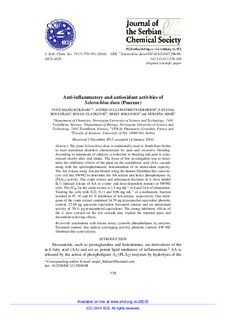| dc.contributor.author | Bukhari, Syed Majid | |
| dc.contributor.author | Feuerherm, Astrid Jullumstrø | |
| dc.contributor.author | Boulfrad, Fayssal | |
| dc.contributor.author | Zlatkovic, Bojan | |
| dc.contributor.author | Johansen, Berit | |
| dc.contributor.author | Simic, Nebojsa | |
| dc.date.accessioned | 2019-11-01T08:43:50Z | |
| dc.date.available | 2019-11-01T08:43:50Z | |
| dc.date.created | 2014-03-06T12:49:16Z | |
| dc.date.issued | 2014 | |
| dc.identifier.citation | Journal of the Serbian Chemical Society. 2014, 79 (7), 779-791. | nb_NO |
| dc.identifier.issn | 0352-5139 | |
| dc.identifier.uri | http://hdl.handle.net/11250/2626036 | |
| dc.description.abstract | The plant Sclerochloa dura is traditionally used in South-East Serbia to treat menstrual disorders characterized by pain and excessive bleeding. According to subjects’ statements, a reduction in bleeding and pain is experienced shortly after oral intake. The focus of this investigation was to determine the inhibitory effects of the plant on the arachidonic acid (AA) cascade alongwith the spectrophotometric determination of antioxidant capacity. The AA release assay was performed using the human fibroblastlike synoviocyte cell line SW982 to determine the AA release and hence phospholipase A2 (PLA2) activity. The crude extract and subsequent fractions of S. dura inhibit IL-1 induced release of AA in a time- and dose-dependent manner in SW982 cells. The IC50 for the crude extract is 1.5 mg/mL at 4 h and 24 h of stimulation. Treating the cells with 0.22, 0.11 and 0.06 mg/mL of methanolic fraction resulted in 97%, 91%, and 63% inhibition of AA-release, respectively. One milligram of the crude extract contained 34.78 μg pyrocatechol equivalent phenolic content, 22.80 μg quercetin equivalent flavonoid content and antioxidant activity of 70.11 μg α-tocopherol equivalents. Strong inhibitory effects of the S. dura extracts on AA cascade may explain the reported pain- and discomfort relieving effects. | nb_NO |
| dc.language.iso | eng | nb_NO |
| dc.publisher | National Library of Serbia | nb_NO |
| dc.title | Anti-inflammatory and antioxidant activities of Sclerochloa dura (Poaceae) | nb_NO |
| dc.type | Journal article | nb_NO |
| dc.type | Peer reviewed | nb_NO |
| dc.description.version | publishedVersion | nb_NO |
| dc.source.pagenumber | 779-791 | nb_NO |
| dc.source.volume | 79 | nb_NO |
| dc.source.journal | Journal of the Serbian Chemical Society | nb_NO |
| dc.source.issue | 7 | nb_NO |
| dc.identifier.doi | 10.2298/JSC131202003B | |
| dc.identifier.cristin | 1120616 | |
| dc.description.localcode | Open Access. | nb_NO |
| cristin.unitcode | 194,66,25,0 | |
| cristin.unitcode | 194,66,10,0 | |
| cristin.unitname | Institutt for kjemi | |
| cristin.unitname | Institutt for biologi | |
| cristin.ispublished | true | |
| cristin.fulltext | original | |
| cristin.qualitycode | 1 | |
